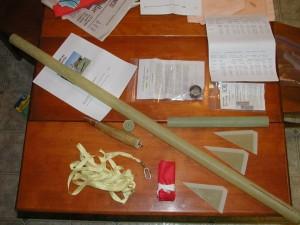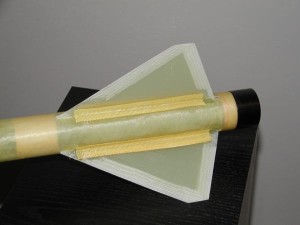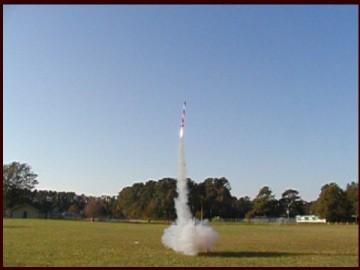| Construction Rating: | starstarstarstarstar_border |
| Flight Rating: | starstarstarstarstar |
| Overall Rating: | starstarstarstarstar_border |
| Manufacturer: | Hawk Mountain Enterprises  |

Brief:
At the foot of the northern slope of Hawk Mountain sits the quiet hamlet of New
Ringgold, Pennsylvania, an unlikely aerie for the fabulous fiberglass rockets
of Hawk Mountain Enterprises. The fledgling of this flock of birds is the
Raptor, an all fiberglass 29mm high power rocket capable of supersonic flights
with large H and 29mm I motors.
Construction:
The Raptor is the smallest (49 inches long) and least expensive Hawk Mountain
rocket. As is the case for all Hawk Mountain kits, the airframe is completely
made of spiral wound fiberglass. It is almost, but not quite a minimum diameter
rocket. There are several options available for the kit but I only chose two of
them. The kit came with:
- 1 42in long 1.3in diameter G-12 airframe fin slots precut
- 3 0.093in G-10 Fins, already shaped
- 1 29mm fiberglass motor mount (optional)
- 1 29mm Slimline retainer (optional)
- 1 24in X-form Chute
- 1 fiberglass piston w/ bulkhead
- 1 Fiberglass nose cone
- 2 Acme 2in conformal launch lugs
- Kevlar® shock cord with a Quick-Link...etc.
One option I did not purchase was the 8in payload section. You may want to buy the payload section if you intend to use dual deployment electronics. The piston is a new feature for this kit, too. It was added to avoid recovery system failures caused by heat shields getting stuck in the airframe during the recovery phase of the flight.
I ordered the kit via a telephone call to Hawk Mountain Enterprise's owner, Alan Gorecki. Alan is a very pleasant fellow and is happy to answer any questions about his kits during a telephone call.
I will make several suggestions at the start. If you don't have a Dremel tool, get one and purchase the 60 grit sanding drums. You must rough up the fiberglass surfaces that will be epoxied and the Dremel tool will make your life so much easier. You'll also need to have J.B. Weld epoxy on hand along with the regular epoxy you may have if you decide to use the Slimline motor retainer (if you go with the Aeropack retainer, the same advice applies).
 The kit
arrived promptly and was packaged well in a sturdy cardboard box. If there is
one area of improvement I could find, it concerns the instructions--they're
sparse and not written with the novice rocketeer in mind. Indeed, there is one
step in the instructions that is out of sequence, concerning the shock cord
attachment to the motor mount tube. First, if you purchased the Slimline motor
retainer, install that on the motor mount per the Slimline directions. Make
certain to use the 600 degree J.B. Weld epoxy to attach the retainer to your
motor mount. Then prepare the motor mount tube for installation in the
airframe. However, before you epoxy the Kevlar®
shock cord onto the motor mount, skip ahead in the instructions to the piston
assembly. Assemble the piston, wait for the epoxy to dry, then slip the aft end
of the shock cord through the hole in the piston bulkhead until you reach the
knot at the 10ft spot on the shock cord. Epoxy the knot to the hole in the
piston. Then, when that's dry, go ahead and epoxy the aft end of the shock cord
to the motor mount tube. Do not use J.B. Weld epoxy to mount the shock cord;
that type of epoxy will not penetrate the weave of the shock cord and
adequately attach the cord to the fiberglass tube.
The kit
arrived promptly and was packaged well in a sturdy cardboard box. If there is
one area of improvement I could find, it concerns the instructions--they're
sparse and not written with the novice rocketeer in mind. Indeed, there is one
step in the instructions that is out of sequence, concerning the shock cord
attachment to the motor mount tube. First, if you purchased the Slimline motor
retainer, install that on the motor mount per the Slimline directions. Make
certain to use the 600 degree J.B. Weld epoxy to attach the retainer to your
motor mount. Then prepare the motor mount tube for installation in the
airframe. However, before you epoxy the Kevlar®
shock cord onto the motor mount, skip ahead in the instructions to the piston
assembly. Assemble the piston, wait for the epoxy to dry, then slip the aft end
of the shock cord through the hole in the piston bulkhead until you reach the
knot at the 10ft spot on the shock cord. Epoxy the knot to the hole in the
piston. Then, when that's dry, go ahead and epoxy the aft end of the shock cord
to the motor mount tube. Do not use J.B. Weld epoxy to mount the shock cord;
that type of epoxy will not penetrate the weave of the shock cord and
adequately attach the cord to the fiberglass tube.
 One
modification that I made to ensure a strong fin attachment to the airframe is
to purchase some 1/2in Kevlar®
tape and cut six strips to fit the root edge for each side of the three fins.
By epoxying the tape in each fin joint, the attachment points to the airframe
are greatly strengthened. First apply some epoxy to the joint, then press a
piece of tape into the joint. Use a popsicle stick to fold the tape so half of
it is on the airframe and half on the fin. Then cover the tape with more epoxy.
Since this rocket has a 24 inch X-fo rm parachute, it recovers quickly and the
tape should go a long way to help avoid having a fin pop off when the rocket
lands. This made the fins quite solid and I was very pleased with the result.
One
modification that I made to ensure a strong fin attachment to the airframe is
to purchase some 1/2in Kevlar®
tape and cut six strips to fit the root edge for each side of the three fins.
By epoxying the tape in each fin joint, the attachment points to the airframe
are greatly strengthened. First apply some epoxy to the joint, then press a
piece of tape into the joint. Use a popsicle stick to fold the tape so half of
it is on the airframe and half on the fin. Then cover the tape with more epoxy.
Since this rocket has a 24 inch X-fo rm parachute, it recovers quickly and the
tape should go a long way to help avoid having a fin pop off when the rocket
lands. This made the fins quite solid and I was very pleased with the result.
At this point, all you need to do is add your chute, assemble your nose cone by epoxying the nose cone bulkhead into the base of the nose cone--it's the one with the screweye attached for you, and attach your launch lugs to complete the construction. The rocket goes together quickly. The most time consuming part is waiting for the J.B. Weld epoxy to totally dry (about 15 hours).
Finishing:
Before you prime the rocket, you should wet sand it with 320 grit wet/dry
sanding paper. Wipe any sanding residue off the airframe and nose cone after
sanding, then prime. I used Duplicolor gray sandable primer on this rocket. I
sanded the first two coats with 320 grit and wet sanded the final coat with 400
grit wet/dry paper. Since I'm using fluorescent paint for the final coat, I had
to put down a white undercoat on top of the gray primer. After the undercoat
dried, I painted the nose cone and one fin flat black and the rest of the
airframe fluorescent red-orange.
Construction Rating: 4 out of 5

Flight:
On October 12, 2003, I flew the Raptor at Nike Carrollton Park located in
Smithfield, Virginia. For her maiden flight, I launched the Raptor on a
F40-10W. The lift off was slow and majestic as the rocket accelerated and flew
into the sky straight as an arrow. After reaching about 1500 feet, the rocket
landed near the launch pads. The piston system worked perfectly.
I decided to go for broke and launched the Raptor on an H128-10W motor. This is where I encountered a problem. Because I followed the Slimline motor retainer manufacturer's instructions to the letter during construction, my Dr. Rocket 29/180 aft closure would not fit in the motor mount and allow me to use the retainer's snap ring. I decided to go for it anyway and try to use masking tape to friction fit the casing. The rocket screamed off the pad, nearly going supersonic. This time the rocket reached around 4000 feet and recovered about 200 yards from the launch pad. Unfortunately, the 200 yards was in the middle of a cotton field, so after trudging through the crop, I was able to recover the rocket. However, the casing was gone.
Never to be accused of leaving well enough alone, I decided to fly her one more time. This time, I put a single use G40-10W motor in her, thinking the rocket would go about 2500 to 3000 feet or so. Again, the Raptor streaked into the sky, like a bat-out-of-hell. It easily passed the 3000 foot mark...and kept going. Finally, the chute was ejected but the rocket must have caught a thermal, drifting far beyond the point of the H motor landing and continued to ride it over some trees in the distance. After an hour of fruitless searching, I couldn't find her.
Recovery:
With the piston system and the Kevlar®
shock cord, no wadding is needed.
Flight Rating: 5 out of 5
Summary:
This rocket is a work of art and as long as it doesn't come in ballistic, it
will survive. The Raptor is a fabulous bargain considering its ruggedness and
features in comparison to the price. The base price for the Raptor is $65.00.
With the two options I purchased, there was an additional cost of $24.35.
However, there are several things I'd change for the next go around. I simply
do not like the Slimline motor retainer. It is vitally important to fit your
motor casing before you glue the retainer in place. I never had that problem
with the Aeropack retainer, which simply screws on/screws off, versus fumbling
with the Slimline's snap ring, so I will opt to go with Aeropack for the next
Raptor. In addition, I think the 24in X-form chute is still too much chute for
this rocket and will lead to it getting lost. I'd suggest going down to an 18
inch x-form or a 15 inch regular chute especially if you follow my suggestion
to reinforce the fins with kevlar®
tape. Heck, you may even want to use a streamer, since this thing is so tough.
With a few modifications, you can own a virtually invulnerable rocket that is capable of supersonic flight on large H and I motors, flies beautifully on F and G motors, and stand a good chance of bringing it home at the end of the day.
Overall Rating: 4 out of 5
Other Reviews
- Hawk Mountain Enterprises Raptor By Alex Bellenie (August 7, 2007)
Brief: The Hawk Mountain Raptor is a near minimum diameter high-performance rocket kit with all fiberglass components, Kevlar shock cord, pre-cut and pre-beveled fins, pre-slotted airframe, and thru-the-wall fin mounting. This sky-puncher can fly on E-I power! Construction: When I ordered this kit, it came on time and packaged in a 4’ x 4” x 4” box with packaging ...
 |
 |
Flights
 |
 |
Sponsored Ads
 |
 |












D.G.L. (November 10, 2003)